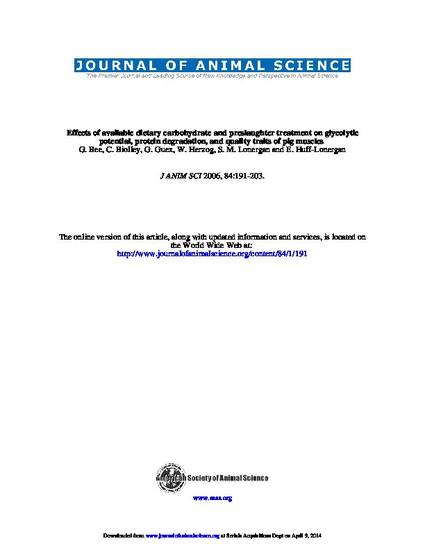
The current study was conducted to determine the interactive effects of a glycogen-reducing diet fed to finishing pigs and length of preslaughter transportion on muscle metabolic traits, proteolysis of intermediate filament and costameric proteins, and meat quality traits. Large White gilts and barrows (n = 48) were selected at 88 kg of BW and individually fed for 21 d a diet (2.6 kg/d) either high (HC) or low (LC) in available carbohydrates. Six gilts and 6 barrows fed the HC and LC diets were subjected to 0 or 3 h of transportation on the day of slaughter. Muscle temperature and pH were measured at 0.5, 1.5, 2.5, 3.5, 4.5, 5.5, and 24 h postmortem in the LM and 24 h postmortem in the dark (STD) and light (STL) portion of the semitendinosus. At 24 h postmortem, glycolytic potential (GP) was determined in the LM, STD, and STL, as well as proteolysis of titin, nebulin, desmin, vinculin, and talin in the LM and STD. The GP was lower (P < 0.05) in muscles from LC-pigs than in muscles from HC-pigs. The LC diet also resulted in lower (P < 0.05) pH, and a darker (P = 0.03), less (P < 0.01) yellow color in the STL. The LC diet decreased (P = 0.04) cooking losses in the STL and STD. The 3-h journey further decreased (P = 0.05) the GP in the STD, regardless of the diet, but transport had no effect (P ≥ 0.67) on the GP of the LM and STL. Ultimate pH of the LM was lower (P = 0.02), and both portions of the semitendinosus were darker (P = 0.01) and less yellow (P < 0.01), in pigs transported 3 vs. 0 h. In pigs transported for 3 h, intact vinculin tended to be more (P = 0.08) degraded in the LM, which coincided with lower (P = 0.04) drip losses in the LM of pigs transported for 3 compared with 0 h. Increased (P < 0.01) proteolysis of titin paralleled lower (P = 0.02) shear force values in the STD of pigs transported 3 vs. 0 h. Although the present results demonstrated the potential of a glycogen-reducing diet to alter the GP of different porcine muscles, the effect of these changes on meat quality traits was limited to higher ultimate pH and darker color in the STL. The positive effects of length of transportation on water-holding capacity (LM and STD) and meat color (STD and STL) were only partially related to the resting muscle glycogen concentration because the 3-h transport lowered the GP only in the muscle with the lowest basal glycogen concentration.
Available at: http://works.bepress.com/steven_lonergan/78/

This article is from Journal of Animal Science 84 (2006): 191–203. Posted with permission.